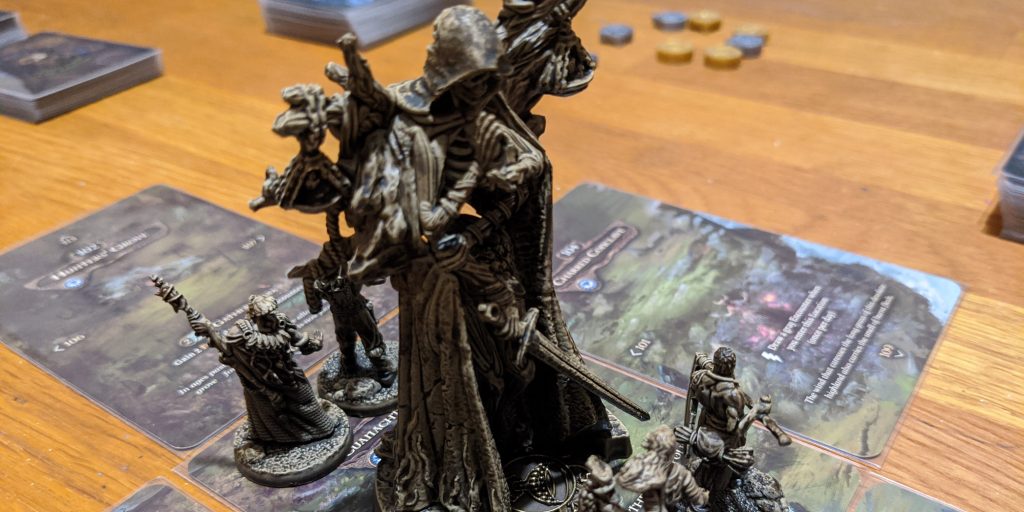Tainted Grail

Tainted Grail: The Fall of Avalon is a Kickstarted boardgame we received a few weeks ago, and got to play last night. First of all, Tainted Grail is a beautiful game. Our version came with sundrop painted miniatures, which though aren’t fully painted, look really nice. As well as the Menhir figures and character figures, we also have a box full of other monsters. We didn’t get to use any of these in our first game, so no pictures yet.
The game itself is a cooperative story based game for up to four players. Each of us played a single character (from a choice of five), each with different statistics and abilities. My character was Ailei, a healer.

Each character comes with a letter from their teacher, which basically says that our superiors have all gone off to save the world, and if they don’t return then we may have to try and do something ourselves.

The letters provide a nice way of introducing the background of each character, and a bit about the world. The Menhir which has protected our village from the weirdness that corrupts this land which was never meant for humans. But it is going dark, and our masters went off to try to find out why. But they have not returned. So we have a limited amount of time before our Menhir dies to figure out how to restore it.
The game initially feels a little bit like the Fallout boardgame. You start with cards which show the location of our village where we all start, as well as the four surrounding locations. As you move, you can uncover new locations, but you cannot see anything which isn’t near a Menhir – so to uncover more locations you need to find and activate more Menhirs. If a Menhir goes dark, then all surrounding locations go dark, which can leave characters trapped, gaining insanity and damage until they die.
Each location has a set of unique actions that can be performed after exploring. Exploration, movement and actions takes energy, and once everyone runs out of energy they need to rest for the night or become exhausted. If you rest, then time ticks on and the clock on each Menhir runs down. You need to explore the world to find clues and complete tasks before the time limit expires.

It’s basically a semi-RPG style of boardgame, with exploration, choices to be made and of course combat. Personally though I found the combat to be confusing and complicated. There are a lot of cards, and you draw three randomly and select which ones to play. They each have different effects, and you have to match symbols on the cards to the last card played in order to chain effects together. The symbols aren’t obvious what they are – the snake head we decided was more like a lamb chop, what looked like a human head was an owl. So there was a lot of confusion trying to describe and understand what was needed. Maybe it’ll become obvious as we play more, but for now combat resolution seems a lot more complicated than it needs to be, without adding anything extra.
There is also a diplomacy mechanic which works in a similar (but not exactly the same) way as combat, and each character has a deck of combat cards and diplomacy cards.
The theme of the game definitely works, and the unfolding story is interesting. There is a book which contains the descriptions and options for each location, as well as a complicated way of unlocking the secrets for that location so you don’t accidentally read them (use dials to find the three digit code which is listed in the back of the book where the secret is recorded).

It was an enjoyable game, and we stopped at the end of the first chapter when we awoke the second Menhir. We had one close call with death, and a lot of running around trying to work out what we needed to do – some characters are better suited to certain locations than others. You have the choice of moving around individually, or as a party. The latter possibly gives a small benefit in combat (I guess you have a bigger selection of cards to choose from, but the enemy gets an attack after each character’s action, so you don’t gain an obvious numerical advantage). Moving individually means you can cover more area.
The game is meant to be played as a campaign, and has sheets to record the state of all the characters (almost like a character sheet…) and the game world. It’s an interesting story game, with beautiful pieces (though the numbers on the dial are a bit too stylised to be easily readable) and made for a great filler whilst we’re between RPG campaigns.
Definitely looking forward to playing more of it, and getting the opportunity to use the rest of the miniatures that came with it. I just hope that I can start to get my head around the combat system.